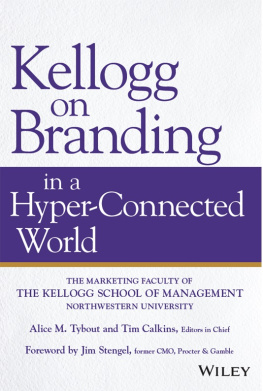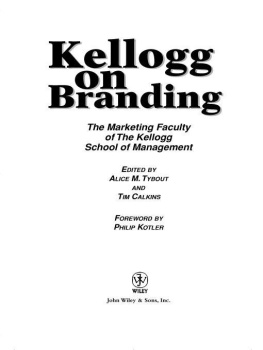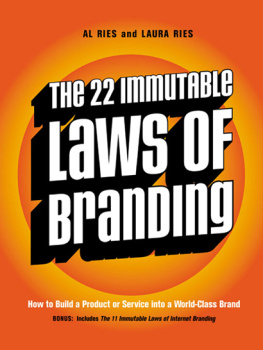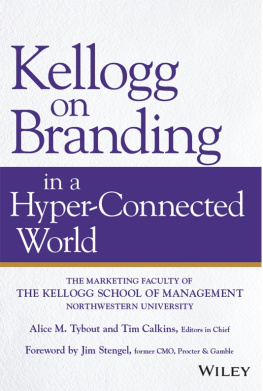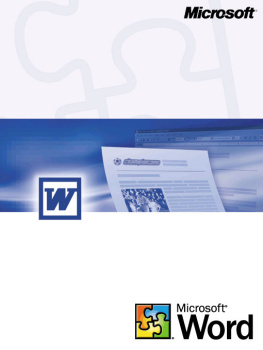Alice M. Tybout - Kellogg on Branding in a Hyper-Connected World
Here you can read online Alice M. Tybout - Kellogg on Branding in a Hyper-Connected World full text of the book (entire story) in english for free. Download pdf and epub, get meaning, cover and reviews about this ebook. year: 2018, genre: Home and family. Description of the work, (preface) as well as reviews are available. Best literature library LitArk.com created for fans of good reading and offers a wide selection of genres:
Romance novel
Science fiction
Adventure
Detective
Science
History
Home and family
Prose
Art
Politics
Computer
Non-fiction
Religion
Business
Children
Humor
Choose a favorite category and find really read worthwhile books. Enjoy immersion in the world of imagination, feel the emotions of the characters or learn something new for yourself, make an fascinating discovery.
- Book:Kellogg on Branding in a Hyper-Connected World
- Author:
- Genre:
- Year:2018
- Rating:4 / 5
- Favourites:Add to favourites
- Your mark:
- 80
- 1
- 2
- 3
- 4
- 5
Kellogg on Branding in a Hyper-Connected World: summary, description and annotation
We offer to read an annotation, description, summary or preface (depends on what the author of the book "Kellogg on Branding in a Hyper-Connected World" wrote himself). If you haven't found the necessary information about the book — write in the comments, we will try to find it.
Kellogg on Branding in a Hyper-Connected World — read online for free the complete book (whole text) full work
Below is the text of the book, divided by pages. System saving the place of the last page read, allows you to conveniently read the book "Kellogg on Branding in a Hyper-Connected World" online for free, without having to search again every time where you left off. Put a bookmark, and you can go to the page where you finished reading at any time.
Font size:
Interval:
Bookmark:

Cover image: xamtiw/iStock.com
Cover design: Wiley
Copyright 2019 by John Wiley & Sons, Inc. All rights reserved.
Published by John Wiley & Sons, Inc., Hoboken, New Jersey.
Published simultaneously in Canada.
No part of this publication may be reproduced, stored in a retrieval system, or transmitted in any form or by any means, electronic, mechanical, photocopying, recording, scanning, or otherwise, except as permitted under Section 107 or 108 of the 1976 United States Copyright Act, without either the prior written permission of the Publisher, or authorization through payment of the appropriate per-copy fee to the Copyright Clearance Center, Inc., 222 Rosewood Drive, Danvers, MA 01923, (978) 7508400, fax (978) 6468600, or on the Web at www.copyright.com. Requests to the Publisher for permission should be addressed to the Permissions Department, John Wiley & Sons, Inc., 111 River Street, Hoboken, NJ 07030, (201) 7486011, fax (201) 7486008, or online at http://www.wiley.com/go/permissions.
Limit of Liability/Disclaimer of Warranty: While the publisher and author have used their best efforts in preparing this book, they make no representations or warranties with respect to the accuracy or completeness of the contents of this book and specifically disclaim any implied warranties of merchantability or fitness for a particular purpose. No warranty may be created or extended by sales representatives or written sales materials. The advice and strategies contained herein may not be suitable for your situation. You should consult with a professional where appropriate. Neither the publisher nor author shall be liable for any loss of profit or any other commercial damages, including but not limited to special, incidental, consequential, or other damages.
For general information on our other products and services or for technical support, please contact our Customer Care Department within the United States at (800) 762-2974, outside the United States at (317) 5723993 or fax (317) 5724002.
Wiley publishes in a variety of print and electronic formats and by print-on-demand. Some material included with standard print versions of this book may not be included in e-books or in print-on-demand. If this book refers to media such as a CD or DVD that is not included in the version you purchased, you may download this material at http://booksupport.wiley.com. For more information about Wiley products, visit www.wiley.com.
Library of Congress Cataloging-in-Publication Data:
ISBN 9781119533184 (Hardcover)
ISBN 9781119533283 (ePDF)
ISBN 9781119533290 (ePub)
In an age of hypercompetition, commoditization, globalization, and rapid technological obsolescence, marketers are struggling to find new conceptual bases on which to design and deliver their marketing programs.
Philip Kotler, Professor Emeritus of Marketing, Northwestern|Kellogg
It has been 14 years since our previous edition of Kelloggs tome on branding. The quote above is from Phil Kotlers foreword to that edition. And it was written pre-iPhone, pre-Uber, pre-Twitter, pre-Alexa, pre-Instagram, and pre-Snapchat, as well as before the explosive strides in artificial intelligence and machine learning. To state the obvious: the world that Kotler described so presciently in 2005 has only become ever more challenging and bewildering for those responsible for building and managing brands.
That is why this book is essential. It is designed to help managers accelerate the growth of brands in this hyper-connected world. It is the best thinking from the most acclaimed marketing and branding school in the country; it is supplemented with wisdom from cutting-edge practitioners from companies such as Ulta, Google, John Deere, and McDonalds.
You will become a better brand builder by reading this book and putting the perspectives and frameworks to work in your business, in your research, or in your classroom. Marketing leaders will find ideas that help them create new markets and differentiate their brands from their competitors. Academics will find sparks that inspire research and guide them as they prepare the next generation of CMOs in their classrooms.
This book arrives not a moment too soon. Branding and marketing has grown in influence and importance for companies since our last edition; a recent study by Deloitte and the CMO Council revealed that CMOs are increasingly responsible for enterprise-level growth and revenue management versus communications management. And the stakes keep getting higher: since 2005, global marketing spending has increased 45 percent to approximately $585.5 billion. Yet, still too many brands are struggling to grow. Witness the sluggish growth of mature brands in categories such as food, beverage, and beauty as small, founder-led brands capture the momentum.
A word of advice on how to leverage the knowledge in this book to full advantage: treat it like a sumptuous buffet. Our book has four parts and 24 chapters, and every chapter is loaded with calories. Consume a chapter or two at a time, and let it settle. Make notes on what struck you, and how you might apply it, share it, test it. And if you approach a buffet as I do (desserts first!), you can go directly to what interests you the most. You do not need to read these chapters in sequence.
Now, get to work. The world is better when we have curious, courageous brand builders who are ready and willing to take on this very important task.
Jim Stengel
The world of branding has changed dramatically in the past decade, and the pace of change only seems to be accelerating. A key force driving both change and complexity is the overwhelming access to people, products, and information. In todays world, we are hyper-connected.
Consumers have an almost infinite range of products and services quite literally at their fingertips, and these options can be delivered, if not instantly, then close to it. Brand managers can connect directly with their customers, track their decision journey, and in many cases make the sale without the assistance of traditional intermediaries. The opportunities are endless for both consumers and managers, and the breadth of options has the potential to be overwhelming.
Although some argue that brands are becoming less important, we believe the oppositethat branding is becoming even more important. Brands provide differentiation, create loyalty, and even foster a sense of identity. Without a powerful, distinctive brand, firms have to rely purely on product-based differentiation, and this can be difficult to maintain.
Our goal in writing and editing this book is to help business leaders navigate this evolving landscape. We do so by drawing upon the perspectives of Kelloggs world-renowned marketing faculty, as well as those of senior executives who put theory into practice as they build and manage brands on a day-to-day basis.
This book is the latest in a series of marketing books from Kellogg, stretching back to 2001 with the publication of Kellogg on Marketing. Four additional books followed: Kellogg on Integrated Marketing (2003), Kellogg on Branding (2005), Kellogg on Advertising and Media (2008), and the second edition of Kellogg on Marketing (2010). These books reflect the collective wisdom of the Kellogg marketing faculty. Thousands of executives have turned to them for perspectives, frameworks, and tools when creating marketing plans and building brands.
Our introduction highlights the power and challenge of branding. The four sections that follow it focus on themes of strategy, implementation, methods, and practical applications.
Next pageFont size:
Interval:
Bookmark:
Similar books «Kellogg on Branding in a Hyper-Connected World»
Look at similar books to Kellogg on Branding in a Hyper-Connected World. We have selected literature similar in name and meaning in the hope of providing readers with more options to find new, interesting, not yet read works.
Discussion, reviews of the book Kellogg on Branding in a Hyper-Connected World and just readers' own opinions. Leave your comments, write what you think about the work, its meaning or the main characters. Specify what exactly you liked and what you didn't like, and why you think so.

